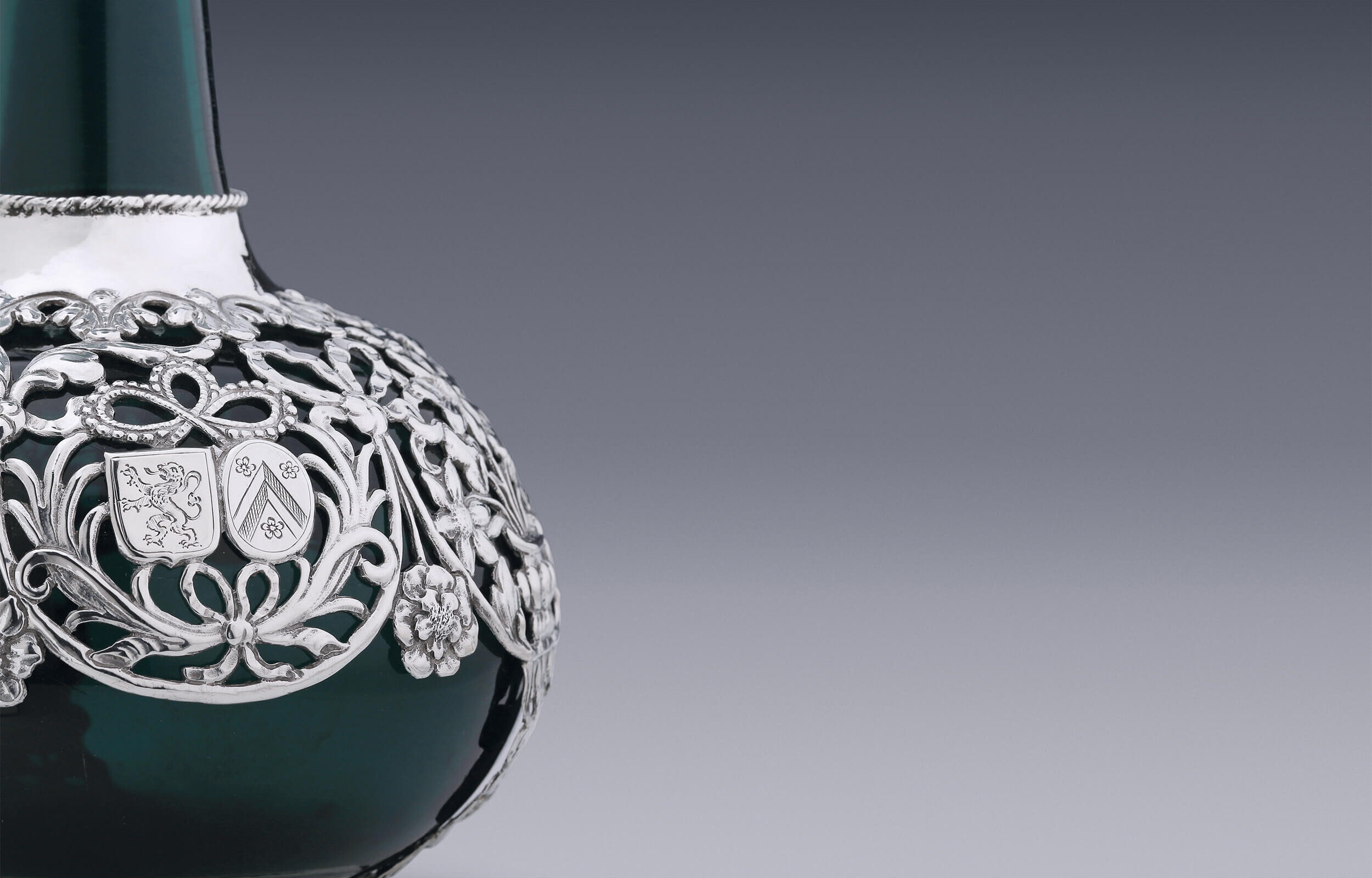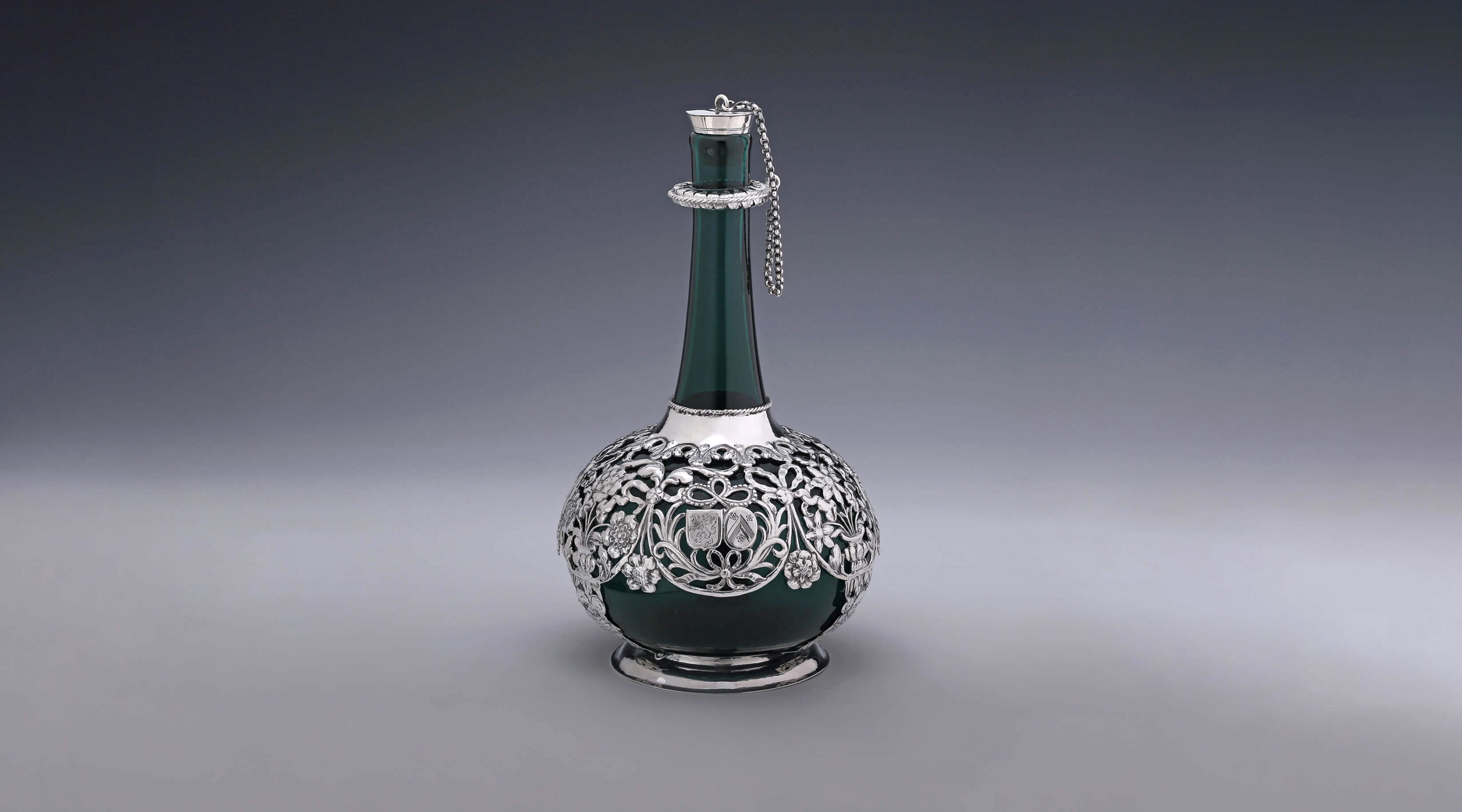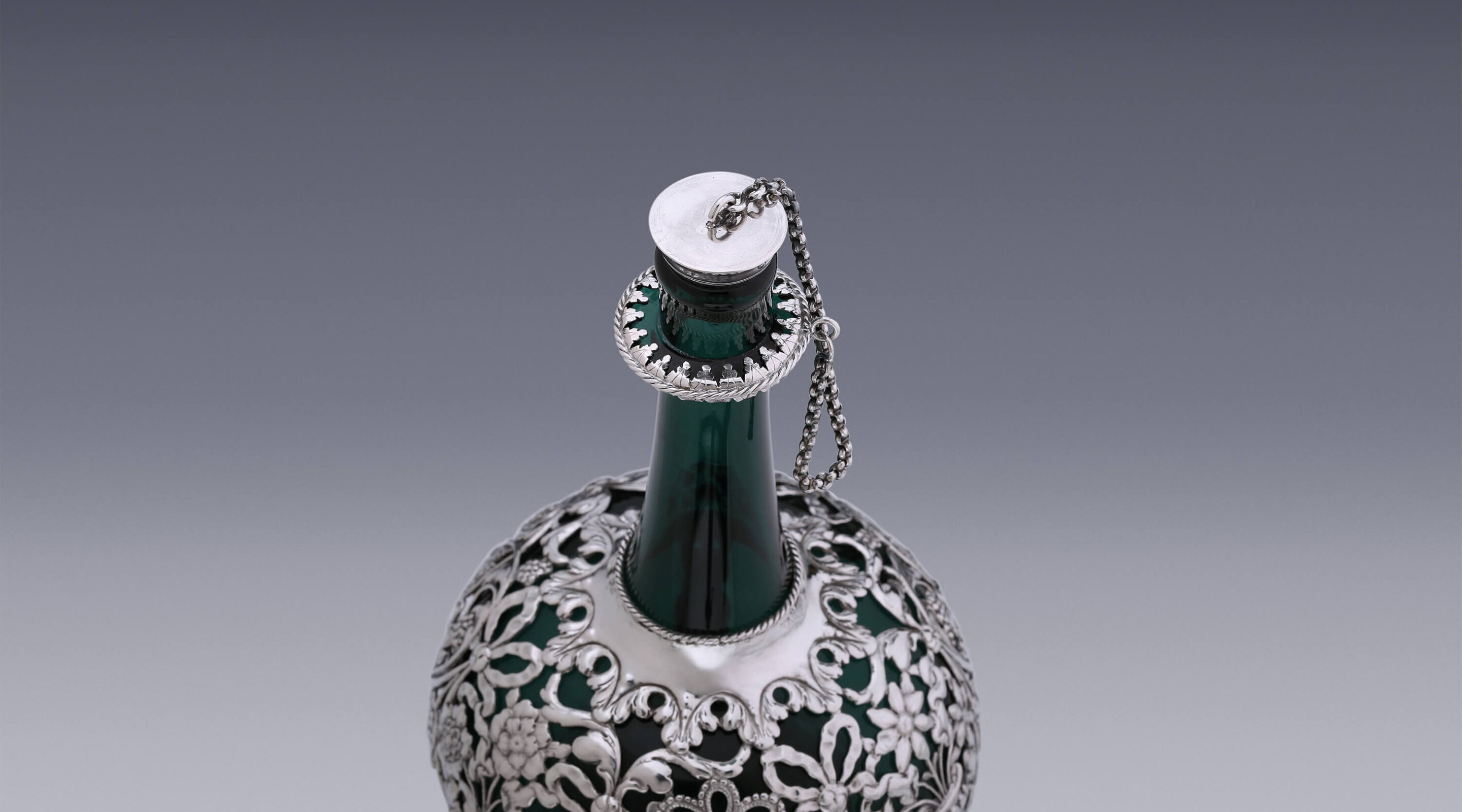To date only fourteen Dutch bottles with silver mounts are known. They were all made in the sixteen-sixties and of similar design. Only two of these bottles were made in Leiden, of which this is one. Only for these Leiden bottles it is known for whom they were made.
This wine bottle has an elaborately decorated silver mount fitted over the top of its globe-shaped body, which contrasts beautifully with the green glass of the bottle. The mount is attached with three silver straps with the same openwork decoration to the plain, gently curved, silver foot ring. Amid the decoration of foliar scrolls, bunches of grapes, flower vases and bows are the arms of alliance of a famous Leiden family.
Two centimetres below the mouth of the bottle’s long, elegant neck is a glass ridge that acts as a drip catcher. It has a silver collar attached around the glass with silver leaves. The plain silver stopper, decorated with a double engraved rim, is attached to the drip-catcher collar with a silver chain.
Isaack Willemszoon van Heemskerck
Of the arms of alliance on the bottle, the escutcheon with a lion rampant on the left is the man’s, beside it is the woman’s escutcheon containing a chevron and three roses. These arms belonged to the Leiden regent Isaack Willemszoon van Heemskerck, who married Margarethe Flament (Flaman) in 1668. Isaack lived in Oude Vest in Leiden where he was born on 25 January 1639. He died in February 1678.
Margaretha, born in Valenciennes in northern France, was the daughter of Maria van Fontaine and Carel Flament. She lived in Breestraat in Leiden and her first marriage was to Pieter Boursse, a merchant from Amsterdam, in 1664. Four years later, in 1668, she married her second husband, Isaack van Heemskerck. This bottle was probably made on the occasion of their marriage.
Willem Jacobszoon van Heemskerck
Isaack Willemszoon van Heemskerck was the son of the cloth merchant Willem Jacobszoon van Heemskerck and his wife Maria van Swanenburgh. Both Willem and his wife came from patrician families. Alongside his work as a cloth merchant, Willem van Heemskerck held various posts in the city administration. In 1674 he became a syndic of the Lakenhal, the cloth-makers’ guild, which conveyed considerable status. In his free time, he wrote poetry and stage plays, and when he was older, he became a gifted engraver of glass.
He gave many of his glasses to friends and relations
The art of engraving glass with calligraphy was usually a pleasant pastime for men and women in the upper classes of society and not of professional calligraphers. This hobby reached its high point in the second half of the seventeenth century. Van Heemskerck gave many of his glasses to friends and relations, and his work rapidly became known and sought-after by collectors. Today his glasses can be found in several museums. Many of the carafes and bottles he engraved are the same model as the wine bottle in this silver mount.
Inheritance
Isaack and Margaretha had two sons, Isaac (born in 1673) and Karel (born in 1674). After Isaack van Heemskerck passed away in 1678, his wife Margaretha married for the third time in 1684 with Lucas van Rijp, doctor of medicine and rector of the Latin School in Leiden. On the occasion of this wedding, Margaretha's 71-year-old father-in-law Willem van Heemskerck engraved a wedding glass. Sadly, her two sons both died young, after which this bottle was most likely inherited by their half-brother Coenraad van Rijp, from Margaretha's third marriage. Coenraad, who was a notary and attorney in Leiden, died childless in 1751. It was probably at that point that this bottle came in the Willer family who also lived in Leiden. Gerard Willer (1736-1802) was, like Willem van Heemskerck, a cloth merchant and a syndic of the cloth-makers’ guild. The bottle has remained in this family ever since.
Second from Leiden
We already find precious metal mounted on expensive materials like glass or rock crystal in the sixteenth century, particularly in German art collections. The idea of enhancing bottles with a silver mount was probably brought to The Hague around 1640 by the silversmith Hans Coenraet Breghtel (1609-1675), who grew up in Nuremberg. Breghtel was a renowned silversmith, who among other things made silver objects for the court in The Hague. There is only one known bottle with silver mounts dating from 1664 by Breghtel, but his pupil and son-in-law Adriaen van Hoecke became the specialist in silver-mounted wine bottles. To date there are fourteen Dutch bottles with silver mounts known. They are very similar in design, a green glass bottle with a long neck and an openwork silver mount decorated with flower motifs and bunches of grapes.
This is the second Leiden example
Of these fourteen bottles, ten were made in The Hague, nine of them by Adriaen van Hoecke. The bottles are part of several museum collections, including the Metropolitan Museum in New York, the Victoria and Albert Museum in London, the Haagse Kunstmuseum in The Hague and Museum Boijmans Van Beuningen in Rotterdam. Including this example, there are only four known bottles that were not made in The Hague. Two were made in Utrecht. The only Leiden bottle known until now is in Museum de Lakenhal in Leiden. This second Leiden example, which bears the same maker’s mark, has decoration very similar to the example in the Leiden Museum. With the exception of the Utrecht examples, all the bottles now known were made in the sixteen-sixties.
Wine in the Seventeenth Century
In the seventeenth century there was virtually no bottled wine. Wine was supplied in wine casks and decanted into decorative bottles in the wine cellar in advance so that the wine could be served in style during the meal.
Beer was the main drink in the Republic. Only wealthy citizens could afford to drink wine. In the first half of the century people drank the only wine that was available, a sweet white Rhine wine. As the seventeenth century progressed, new wine-growing countries and regions were discovered, such as in Spain, the Loire and Bordeaux. Thanks to the draining of the land, the Dutch had good trading connections, so red wine easily found its way to the Low Countries, where – despite the high tax levied on wine – it became very popular among the growing elite.
Bolschacht
The most widely manufactured bottle in the world is without doubt the wine bottle. The production of domestic bottles began in the sixteenth century, and people soon discovered that glass was ideal for ‘packaging’ wine or pouring it out. The most common bottle in the Republic was the ‘Kattekop’, a bottle with a round body and a short neck. They were made in large numbers.
It is the oldest type of wine bottle
The elegant model bottle for which silver mounts were made was the Bolschacht, a shaft and globe bottle with a longer, more slender neck. This type of bottle was manufactured in the period from about 1630 to 1680 and is the oldest type of wine bottle. Without a silver mount these bottles are quite unstable and vulnerable so it is relatively rare nowadays to find one in perfect condition. Most examples are damaged finds retrieved from cesspits or shipwrecks.
The silver mount is marked on the underside of the foot ring with the maker’s mark of three flowers on a stem with leaves growing out of a heart used by an unidentified Leiden silversmith.



